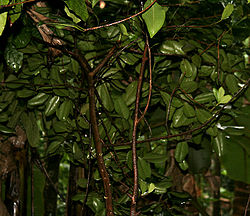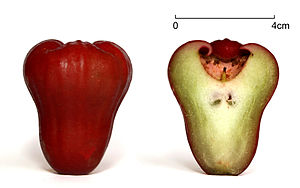- Myrtaceae
-
Myrtle family 
Myrtus communis foliage and flowers Scientific classification Kingdom: Plantae Division: Magnoliophyta Class: Magnoliopsida Order: Myrtales Family: Myrtaceae
Juss.Genera About 130; see list
The Myrtaceae or Myrtle family are a family of dicotyledon plants, placed within the order Myrtales. Myrtle, clove, guava, feijoa, allspice, and eucalyptus belong here. All species are woody, with essential oils, and flower parts in multiples of four or five. One notable character of the family is that the phloem is located on both sides of the xylem, not just outside as in most other plants. The leaves are evergreen, alternate to mostly opposite, simple, and usually with an entire (not toothed) margin. The flowers have a base number of five petals, though in several genera the petals are minute or absent. The stamens are usually very conspicuous, brightly coloured and numerous.
Contents
Varieties
Recent estimates suggest that Myrtaceae has over 5650 species (Govaerts et al. 2008), occurring in some 130-150 genera. The family has a wide distribution in tropical and warm-temperate regions of the world, and are typically common in many of the world's biodiversity hotspots. Genera with capsular fruits such as Eucalyptus, Corymbia, Angophora, Leptospermum, Melaleuca, Metrosideros are absent from the Americas, apart from the monotypic genus Tepualia in Chile and Argentina. Genera with fleshy fruits have their greatest concentrations in eastern Australia and Malesia (the Australasia ecozone) and the Neotropics. Eucalyptus is a dominant, nearly ubiquitous genus in the more mesic parts of Australia and extends north sporadically to the Philippines. Eucalyptus regnans is the tallest flowering plant in the world. Other important Australian genera are Callistemon (bottlebrushes), Syzygium, and Melaleuca (paperbarks). The genus Osbornia, native to Australasia, are mangroves. Eugenia, Myrcia, and Calyptranthes are among the larger genera in the neotropics.
Historically, the Myrtaceae were divided into two subfamilies. Subfamily Myrtoideae (ca. 75 genera) was recognized as having fleshy fruits and opposite, entire leaves. Most genera in this subfamily have one of three easily recognized types of embryos. The genera of Myrtoideae can be very difficult to distinguish in the absence of mature fruits. The Myrtoideae are found worldwide in subtropical and tropical regions, with centres of diversity in the Neotropics, northeastern Australia, and Malesia. In contrast, Subfamily Leptospermoideae (ca. 80 genera) were recognized as having dry, dehiscent fruits (capsules) and leaves arranged spirally or alternate. The Leptospermoideae are found mostly in Australasia, with a centre of diversity in Australia. Many genera in Western Australia have greatly reduced leaves and flowers typical of more xeric habitats.
The division of the Myrtaceae into the Leptospermoideae and Myrtoideae was challenged by a number of authors, including Johnson and Briggs (1984), who identified 14 tribes or clades within the Myrtaceae, and found the Myrtoideae to be polyphyletic. Molecular studies by several groups of authors, as of 2008, have confirmed that the baccate (fleshy) fruits evolved twice from capsular fruits, and as such the two subfamily classification does not accurately portray the phylogenetic (= evolutionary) history of the family. Thus many workers are now using a recent analysis by Wilson et al. (2001) as a starting point to test further analyses of the family.
The genera Heteropyxis and Psiloxylon have been separated as separate families by many authors in the past as Heteropyxidaceae and Psiloxylaceae. However, Wilson et al. (2001) included Heteropyxis and Psiloxylon in Myrtaceae. These two genera are presently believed to be the earliest arising and surviving lineages of Myrtaceae.
Many new species are being described annually from throughout the range of Myrtaceae. Likewise, new genera are being described nearly yearly.
Genera
- Accara
- Acmena
- Acmenosperma
- Actinodium
- Agonis
- Algrizea
- Allosyncarpia
- Amomyrtella
- Amomyrtus
- Angasomyrtus
- Angophora
- Archirhodomyrtus
- Arillastrum
- Astartea
- Asteromyrtus
- Austromyrtus
- Backhousia
- Baeckea
- Balaustion
- Barongia
- Basisperma
- Beaufortia
- Blepharocalyx
- Callistemon
- Calothamnus
- Calycolpus
- Calycorectes
- Calyptranthes
- Calyptrogenia
- Calythropsis
- Calytrix
- Campomanesia
- Carpolepis
- Chamelaucium
- Chamguava
- Choricarpia
- Cleistocalyx
- Cloezia
- Conothamnus
- Corymbia
- Corynanthera
- Cupheanthus
- Curitiba
- Darwinia
- Decaspermum
- Dryobalanops
- Eremaea
- Eucalyptopsis
- Eucalyptus
- Eugenia
- Feijoa (syn. Acca)
- Gomidesia
- Gossia
- Hexachlamys
- Homalocalyx
- Homalospermum
- Homoranthus
- Hottea
- Hypocalymma
- Kanakomyrtus
- Kania[disambiguation needed
 ]
] - Kjellbergiodendron
- Kunzea
- Lamarchea
- Legrandia
- Lenwebbia
- Leptospermum
- Lindsayomyrtus
- Lithomyrtus
- Lophomyrtus
- Lophostemon
- Luma
- Lysicarpus
- Mallostemon
- Marlierea
- Melaleuca
- Meteoromyrtus
- Metrosideros
- Micromyrtus
- Mitranthes
- Mitrantia
- Monimiastrum
- Mosiera
- Myrceugenia
- Myrcia
- Myrcianthes
- Myrciaria
- Myrrhinium
- Myrtastrum
- Myrtella
- Myrteola
- Myrtus
- Neofabricia
- Neomitranthes
- Neomyrtus
- Ochrosperma
- Octamyrtus
- Osbornia
- Paramyrciaria
- Pericalymma
- Phymatocarpus
- Pileanthus
- Pilidiostigma
- Piliocalyx
- Pimenta
- Pleurocalyptus
- Plinia
- Pseudanamomis
- Psidium
- Purpureostemon
- Regelia
- Rhodamnia
- Rhodomyrtus
- Rinzia
- Ristantia
- Sannantha
- Scholtzia
- Seorsus
- Siphoneugena
- Sphaerantia
- Stereocaryum
- Stockwellia
- Syncarpia
- Syzygium
- Taxandria
- Tepualia
- Thaleropia
- Thryptomene
- Tristania
- Tristaniopsis
- Ugni
- Uromyrtus
- Verticordia
- Waterhousea
- Welchiodendron
- Whiteodendron
- Xanthomyrtus
- Xanthostemon
References
- Govaerts, R. et al. (12 additional authors). 2008. World Checklist of Myrtaceae. Royal Botanic Gardens, Kew. xv + 455 pp.
- Johnson, L.A.S. and Briggs, B.G. 1984. Myrtales and Myrtaceae – a phylogenetic analysis. Annals of the Missouri Botanic Garden 71: 700-756.
- Wilson, Peter G., O'Brien, Marcelle M., Gadek, Paul A., and Quinn, Christopher J. 2001. "Myrtaceae Revisited: A Reassessment of Infrafamilial Groups". American Journal of Botany 88 (11): 2013–2025. Available online (pdf file).
- Sytsma, Kenneth J. and Amy Litt. 2002. Tropical disjunctions in and among the Myrtaceae clade (Myrtaceae, Heteropyxidaceae, Psiloxylaceae, Vochysiaceae): Gondwanan vicariance or dispersal? (Abstract). Botany 2002 Conference, University of Wisconsin, Madison, Wisconsin, August 4-7 2002.
External links
Categories:- Myrtaceae
- Myrtales families
Wikimedia Foundation. 2010.


